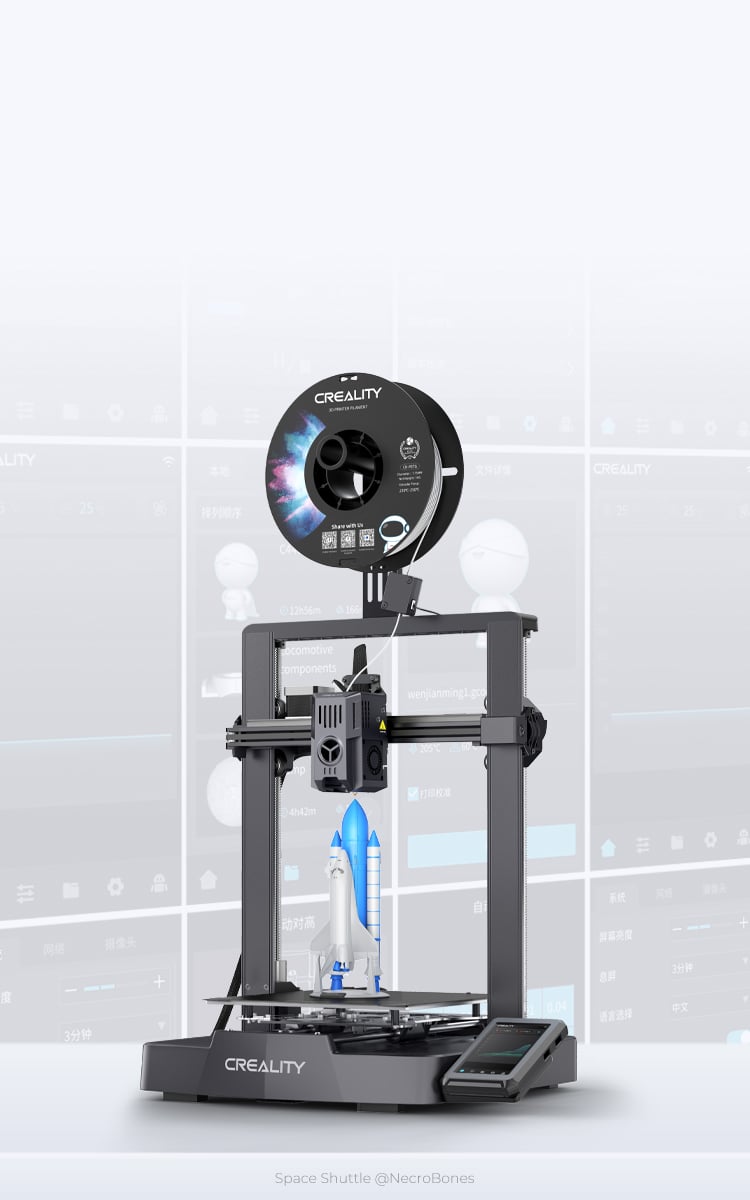The Creality Ender 3 V3 KE has quickly become a standout option in the 3D printing world. Released as an upgraded version of the popular Ender series, this printer combines impressive speed with precision engineering. The Ender 3 V3 KE can reach printing speeds of up to 500mm/s with 8000mm/s² acceleration, making it significantly faster than many competitors in its price range.
This model comes equipped with Klipper firmware, a direct drive extruder, and an all-metal frame for durability. The printer features a powerful 60W ceramic heater that fully melts filaments for high-speed printing, along with a bi-metal heatbreak that prevents thermal creep. Its copper nozzle can reach temperatures up to 300°C, allowing users to work with a wide variety of filament types.
Users report positive experiences with the Ender 3 V3 KE, noting its ease of use and reliability. Some have enhanced their results by adding accessories like vibration sensors. The printer’s combination of speed, precision, and user-friendly design makes it an excellent choice for both beginners and experienced makers looking to upgrade their 3D printing capabilities.

Creality Ender 3 V3 KE — Latest Features & Performance Review (2025)
The Creality Ender 3 V3 KE is one of the latest iterations in the popular Ender 3 lineup, bringing Klipper-assisted speed, modern usability features, and affordable pricing to hobbyist and prosumer 3D printing.
1. Overview
- Release Date: Late 2023
- Printer Type: FDM (Fused Deposition Modeling)
- Target Users: Beginners to intermediate makers
- Price Range (2025): Around $300–$350 USD (varies by region)
2. Latest Features
✅ Klipper Firmware Support
- Ships with Creality OS based on Klipper, enabling much faster print speeds and smoother motion control compared to stock Marlin firmware.
✅ High-Speed Printing
- Max Speed: Up to 500 mm/s (realistic quality prints around 250–300 mm/s).
- Acceleration: Up to 8000 mm/s², reducing print times significantly.
✅ Direct Drive Extruder
- Improved filament control, especially for flexible materials like TPU.
- Reduces stringing and improves retraction accuracy.
✅ Dual Z-Axis
- Better stability for taller prints.
- Minimizes layer shifting and wobble.
✅ Automatic Bed Leveling
- Uses CR Touch probe for 100% auto bed leveling.
- First-layer consistency is greatly improved.
✅ Touchscreen Interface
- 4.3-inch color touchscreen with intuitive UI.
- Real-time print status, temperature control, and file navigation.
✅ Silent Stepper Drivers
- Quieter operation thanks to TMC drivers.
- Ideal for home workshops or offices.
3. Build Volume
- 220 × 220 × 240 mm — standard for Ender 3 series, enough for most hobbyist projects.
4. Performance Review
Print Quality
- Excellent detail at standard speeds (60–100 mm/s).
- At high speeds (250–300 mm/s), quality remains good, with minimal ringing thanks to Klipper tuning.
Material Compatibility
- PLA, PETG, TPU, ABS (with enclosure), and some nylons.
- Direct drive makes flexible filament printing much easier.
Reliability
- Auto bed leveling and dual Z-axis improve print success rates.
- Well-built frame reduces maintenance needs.
Noise Level
- Very quiet — fans are the loudest component during operation.
5. Pros & Cons
Pros
- Fast printing with Klipper integration
- Easy setup for beginners
- Direct drive for flexible filaments
- Quiet operation
- Affordable for the feature set
Cons
- Build volume is unchanged from older Ender 3 models
- No enclosure included (needed for ABS/nylon)
- Klipper interface is basic compared to a full Raspberry Pi setup
6. Who Should Buy It
- Great for: Hobbyists, makers who want faster prints without heavy modding, and beginners looking for an easy first printer.
- Not ideal for: Industrial-scale printing or very large models.
7. Verdict
The Creality Ender 3 V3 KE delivers high-speed performance, modern convenience features, and solid print quality at a budget-friendly price. It’s one of the best-value printers under $400 in 2025, especially for those who want Klipper speeds without DIY firmware flashing.
Key Takeaways
- The Ender 3 V3 KE delivers exceptional speed at 500mm/s while maintaining precision through Klipper firmware and a direct drive system.
- High-temperature capabilities (up to 300°C) and quality components like the copper nozzle enable printing with diverse filament types.
- The printer offers an intuitive user experience with a durable all-metal frame that suits both beginners and professional users.
Technical Specifications
The Ender 3 V3 KE packs impressive specs in an affordable package, featuring high printing speeds up to 500 mm/s, precise layer resolution, and compatibility with multiple filament types.
Print Capabilities
The Ender 3 V3 KE features a respectable build volume of 220 x 220 x 240 mm (8.7 x 8.7 x 9.4 inches), providing ample space for most common printing projects. Its layer resolution ranges from 0.1 to 0.35 mm, offering flexibility between fine detail and faster prints.
Speed is where this printer truly excels, with a maximum printing speed of 500 mm/s and acceleration of 8,000 mm/s². This makes it significantly faster than most competitors in its price range.
The printer supports a variety of filaments including:
- Hyper PLA
- PETG
- ABS
- TPU (95A)
- ASA
Temperature capabilities reach up to 300°C, ensuring compatibility with materials requiring higher melting points. The printer maintains a precision of ±0.1mm, delivering consistent quality even at higher speeds.
Hardware Enhancements
The Ender 3 V3 KE comes equipped with a single extruder system optimized for reliable feeding and reduced stringing. Auto-leveling functionality significantly improves first layer adhesion and overall print success rates.
The printer includes a PEI-coated spring steel build plate, making print removal easier while ensuring excellent adhesion during printing. This plate is also removable and flexible, further simplifying the process of removing completed prints.
The frame construction provides improved stability compared to previous models, reducing vibrations that can affect print quality at high speeds. The power supply is UL-certified for safety, with thermal runaway protection for peace of mind during longer print jobs.
Cooling has been enhanced with improved fan placement and airflow design, helping maintain quality even when printing at maximum speeds.
Software and Connectivity
The Ender 3 V3 KE offers versatile connectivity options including USB, microSD card, and network capabilities. LAN printing allows direct connection to your home network, while cloud printing enables remote monitoring and control of print jobs.
The printer is compatible with popular slicing software including:
- Creality Print Software (officially supported)
- Cura
- Simplify3D
The touchscreen interface provides real-time model previews and intuitive control options. Users can monitor printing progress, adjust settings, and make real-time modifications without connecting to a computer.
The firmware supports power loss recovery, automatically resuming prints after unexpected power interruptions. Filament runout detection pauses printing when material is depleted, preventing failed prints and wasted time.
Updates can be installed via USB or network connection, keeping the printer’s functionality current with minimum hassle.
Ender 3 V3 Series Comparison
| Feature | Ender 3 V3 KE | Ender 3 V3 SE | Ender 3 V3 |
|---|---|---|---|
| Firmware | Creality OS (Klipper-based) | Standard Marlin | Creality OS (Klipper-based) |
| Max Print Speed | 500 mm/s (real ~250–300 mm/s) | 250 mm/s | 600 mm/s (real ~300–350 mm/s) |
| Acceleration | Up to 8000 mm/s² | Up to 2500 mm/s² | Up to 20000 mm/s² |
| Build Volume | 220 × 220 × 240 mm | 220 × 220 × 250 mm | 220 × 220 × 250 mm |
| Extruder Type | Direct drive | Bowden | Direct drive |
| Bed Leveling | CR Touch auto leveling + manual assist | Manual + assisted | CR Touch auto leveling |
| Touchscreen | 4.3″ color | Basic knob LCD | 4.3″ color |
| Dual Z-Axis | Yes | No | Yes |
| Noise Level | Low (silent drivers) | Medium | Low (silent drivers) |
| Material Support | PLA, PETG, TPU, ABS* | PLA, PETG | PLA, PETG, TPU, ABS* |
| Price (2025) | ~$300–$350 | ~$200–$250 | ~$400–$450 |
| Best For | Speed + ease of use | Budget beginners | Maximum speed + advanced users |
*ABS and nylon printing require an enclosure for all models.
💡 Quick Take
- Ender 3 V3 KE → Best balance of speed, features, and price.
- Ender 3 V3 SE → Best for tight budgets and basic PLA/PETG printing.
- Ender 3 V3 → Best for power users who want the fastest speeds and highest acceleration.
Filament Compatibility and Print Quality
The Ender 3 V3 KE offers extensive compatibility with various filament types and delivers impressive print quality through its enhanced features. Its advanced hotend and cooling system work together to handle multiple materials with precision.
Supported Filament Types
The Ender 3 V3 KE supports a wide range of filaments, making it versatile for different printing needs. It handles standard PLA filament with ease at recommended temperatures of 230-250°C (optimally at 240°C).
The printer also works well with more technical materials including:
- ABS (requiring bed temperatures of 75-90°C)
- PETG (excellent for functional parts)
- TPU (for flexible prints)
- Nylon (including carbon fiber-infused varieties)
The 60W ceramic heater enables the hotend to reach and maintain high temperatures needed for specialized materials like PC and ASA. This expanded material compatibility makes the V3 KE suitable for both beginners and advanced users seeking to experiment with different filament properties.
Quality Assurance in Printing
Print quality on the Ender 3 V3 KE benefits significantly from its superior hotend design and dual cooling system. The printer features double fans that provide rapid model cooling, essential for achieving clean overhangs and crisp details.
For optimal results with different materials:
- Set bed temperature between 75-90°C for materials like ABS
- Adjust fan speed based on filament type (lower for ABS, higher for PLA)
- Utilize the printer’s typical printing speeds of up to 250mm/s for regular prints
The upgraded 4.3-inch color touchscreen makes it easy to fine-tune these settings during printing. The combination of precise temperature control and effective cooling ensures excellent layer adhesion and surface finish across various filament types.
Users report particularly good results with PLA and PETG, with the printer handling even more demanding materials like nylon with proper setup adjustments.
User Experience and Interface
The Ender 3 V3 KE delivers an impressive user experience with its modern interface and thoughtful safety features. Users consistently praise the printer’s smooth operation and intuitive controls that make 3D printing accessible to beginners while offering advanced functionality for experienced makers.
Interactive UI Design
The Ender 3 V3 KE features a responsive touch UI that significantly improves user interaction compared to older models. The interface includes global navigation buttons that make accessing different functions quick and intuitive. Users can easily navigate through print settings, calibration options, and maintenance features.
The dynamic display provides real-time feedback on print progress, temperatures, and other critical parameters. This makes monitoring prints much easier without needing to connect to external software. Many users appreciate the black-themed interface that’s easy on the eyes during long print sessions.
The web interface capability offers similar functionality to Octoprint, allowing users to control the printer remotely. This feature has become particularly popular among users who want to check on prints from another room or start new projects without being physically present at the machine.
Safety and Stability Features
The Ender 3 V3 KE incorporates several safety features that enhance reliability during operation. The smart self-test function automatically checks critical components before printing, reducing the risk of failed prints or equipment damage.
The auto-leveling system simplifies one of the most challenging aspects of 3D printing. Users report the bed leveling process is much more reliable than previous models, saving time and frustration during setup.
The PEI flexible build plate improves print adhesion while making part removal easier. This practical feature reduces the risk of damaging printed objects during removal.
The printer’s stability is enhanced by its ultra-smooth motion system. The X-axis linear rail and improved linear guides create significantly smoother movement compared to the V-wheel system in older models. This stability, combined with effective vibration compensation, allows for faster printing speeds without sacrificing quality.
Advanced Functionality
The Ender 3 V3 KE combines cutting-edge technology with user-friendly features to deliver exceptional printing capabilities. Its advanced systems support high-speed printing while maintaining quality through specialized hardware and software integration.
Innovative Features
The Ender 3 V3 KE incorporates several innovative features that set it apart from previous models. One standout addition is the optional AI Camera system, which enables real-time monitoring of print progress from anywhere through the Creality Cloud App. This monitoring capability allows users to manage multiple printers simultaneously.
The printer’s advanced hotend design can reach temperatures up to 300°C, making it compatible with a wide range of materials including Hyper PLA, PETG, ABS, TPU(95A), and ASA. This versatility expands the potential applications for home and professional use.
Another key improvement is the integrated Vibration Compensation Sensor. This technology actively detects and counters printer vibrations, particularly important when printing at its impressive 500 mm/s maximum speed.
Enhancing Printing Dynamics
The Ender 3 V3 KE utilizes sophisticated algorithms to optimize printing performance. Input Shaping and Motion Advance technologies work together to reduce ringing and improve corner quality, even at high speeds.
Print quality is maintained through smart acceleration controls that automatically adjust printing parameters based on the geometry being printed. This allows the printer to slow down for detailed sections and speed up for simple structures.
The FFF (Fused Filament Fabrication) process benefits from these dynamics, with users reporting Benchy prints completed in approximately 15 minutes – a significant improvement over standard printing times.
For optimal results at high speeds, pressure advance settings can be fine-tuned through start G-code commands. These adjustments progressively change with each layer, allowing users to identify ideal settings for their specific printing needs.
Frequently Asked Questions
The Ender 3 V3 KE offers several important features and capabilities that set it apart from other 3D printers. Users often have specific questions about its performance, materials compatibility, and value compared to similar models.
What are the distinguishing features of the Ender 3 V3 KE?
The Ender 3 V3 KE features a direct drive extruder system that improves filament control and allows for better printing with flexible materials. It comes equipped with a Creality K1 series core-XY motion system for faster and more precise printing.
The printer includes automatic bed leveling technology, which significantly reduces setup time and improves first layer adhesion. It also features a color touchscreen interface that makes operation more intuitive for beginners and experienced users alike.
How does the Ender 3 V3 KE compare to the Ender 3 V3 SE in terms of performance?
The V3 KE offers faster printing speeds than the SE model, with capabilities of up to 600mm/s in optimal conditions. The KE also provides better print quality at higher speeds due to its improved motion system and extruder design.
While the SE is more budget-friendly, the KE delivers superior performance when printing complex models or using specialty filaments. The KE also features a more robust build platform and better temperature stability for consistent results.
What improvements are included in the Ender 3 V3 KE model?
The V3 KE includes significant upgrades to the cooling system, with dual part cooling fans that improve bridging and overhang performance. The printer features an all-metal hot end capable of reaching higher temperatures than previous models.
Creality has also improved the firmware with better user interface and more advanced slicing options. The KE includes a filament runout sensor and power loss recovery, making longer prints more reliable.
What materials can the Ender 3 V3 KE successfully print with?
The Ender 3 V3 KE can successfully print with PLA, ABS, PETG, and TPU due to its direct drive extruder and all-metal hot end. The printer handles flexible filaments particularly well compared to bowden extruder models.
Some users have reported issues with clogging after printing ABS, as mentioned in the search results. This suggests that proper maintenance is important when switching between different filament types.
The printer’s heated bed and enclosed design help maintain consistent temperatures for materials that are prone to warping.
Are there any detailed reviews available that assess the Ender 3 V3 KE’s capabilities?
Several technology and 3D printing websites have published comprehensive reviews of the Ender 3 V3 KE. These reviews typically include detailed analysis of print quality, speed capabilities, and ease of use.
Many user reviews can be found on the Creality Community Forum, where owners discuss their experiences with the printer. Common discussions include troubleshooting tips for issues like bed adhesion problems and print failures.
YouTube channels dedicated to 3D printing often feature video reviews that demonstrate the printer’s capabilities with various materials and settings.
How does the price of the Ender 3 V3 KE compare to other models in the Ender 3 series?
The Ender 3 V3 KE is positioned as a mid-to-high tier model in the Ender 3 lineup, costing more than the basic Ender 3 and the V3 SE models. The price difference reflects its advanced features and improved performance capabilities.
When compared to the original Ender 3, the price increase is substantial, but many users find the additional features justify the cost. The V3 KE offers better value for those who need higher print speeds and material versatility.
Despite being more expensive than entry-level models, the V3 KE remains more affordable than Creality’s premium offerings like the K1 series.







